Starfield: A XenGamer.

Bethesda Game Studios has finally delivered Starfield, a sprawling spacefaring RPG promising unparalleled freedom and exploration. But does it live up to the immense hype? As seasoned PC gamers, we demand more than just pretty planets and lofty promises. This is XenGamer.com, and we're here to give you the incisive, no-nonsense analysis you deserve. Buckle up, because we're diving deep into Starfield's gameplay, narrative, graphics, performance, and modding potential, all from a PC-centric perspective.
The official cover art of Starfield, featuring key characters against a stunning nebula backdrop, sets high expectations for the game's scope and visual fidelity.
Gameplay & Mechanics: Ship Customization and The Vasco Effect
Starfield places a heavy emphasis on ship customization, and for good reason. Your ship isn't just a vehicle; it's your mobile base, your trading hub, and your weapon in the vast expanse of space. The depth of customization is impressive, allowing you to fine-tune nearly every aspect, from the Grav Drive to the weapon arrays.
The choice of ship components drastically impacts gameplay. For example, swapping out the Ares Bridge Grav Drive from HopeTech for the Stroud-Eklund Eklund-E40 Grav Drive resulted in a 3 light-year jump range increase on my mid-sized freighter. This seemingly small change opened up new star systems and trading opportunities previously out of reach.
Weapon arrays are equally crucial. Particle beams offer sustained damage against shields, while ballistic cannons excel at tearing through hulls. A well-rounded approach is often best, allowing you to adapt to different combat scenarios. As for shields, the Nova Galactic 700 Series Shield Generator provides a solid balance of capacity and recharge rate, making it a reliable choice for most encounters. However, the Vanguard Bulwark Shield System offers superior protection but comes at the cost of increased power consumption.
Hab modules determine the functionality and comfort of your ship. Choosing the right modules for your play style is paramount, whether you're focused on trading, combat, or exploration. Trading ships should prioritize cargo holds, while combat vessels benefit from engineering bays that boost weapon performance.
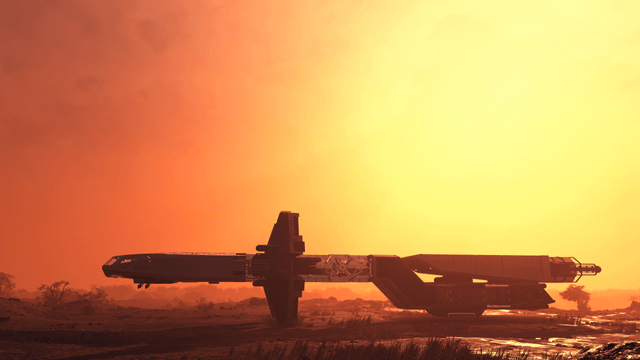 A dynamically customized ship engaged in a fierce space battle, showcasing the Grav Drive's glow, weapon systems in action, and enemy ships exploding against a vivid nebula background.
A dynamically customized ship engaged in a fierce space battle, showcasing the Grav Drive's glow, weapon systems in action, and enemy ships exploding against a vivid nebula background.
The Vasco Effect: Your initial companion, Vasco, isn't just a tin can with a pre-programmed greeting. His robotics skill provides a significant boost to ship systems, increasing weapon damage and shield effectiveness. In ship combat, Vasco acts as an invaluable crew member, automatically repairing damaged systems and providing tactical support. He even has unique dialog, offering observations on your surroundings and occasional dry humor. While not game-changing, Vasco's presence subtly enhances the overall experience.
Narrative Analysis: Crimson Fleet vs. UC Vanguard – Morality's Compass
Starfield presents players with a multitude of choices, and few are as impactful as aligning with either the Crimson Fleet or the UC Vanguard. This isn't a simple case of good versus evil; both factions operate in morally grey areas, forcing players to confront difficult choices with far-reaching consequences.
The Crimson Fleet, a band of space pirates operating from the dimly lit and claustrophobic Key station, offers a path of illicit gains and ruthless pragmatism. Joining them unlocks unique questlines involving smuggling, raiding, and sabotage. However, this path comes at the cost of your reputation with other factions, and you'll find yourself constantly looking over your shoulder. Think the Thieves Guild from Skyrim, but in space, with higher stakes and potential for galactic-scale conflict.
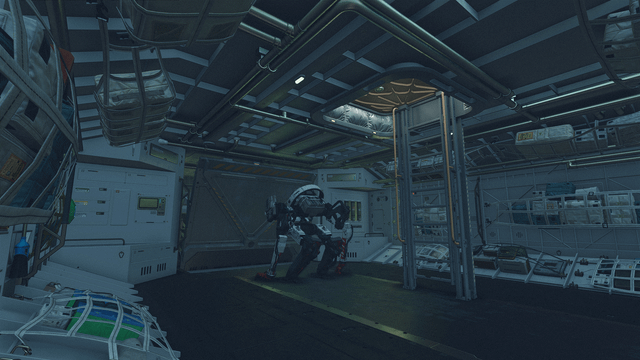 Vasco stands proudly on the player's ship, showcasing the personalized interior and lighting, representing his role as a loyal companion in the player's journey.
Vasco stands proudly on the player's ship, showcasing the personalized interior and lighting, representing his role as a loyal companion in the player's journey.
Enlisting in the UC Vanguard, the United Colonies' defense force headquartered in the pristine and futuristic New Atlantis, offers a more lawful path. You'll be tasked with protecting the colonies from external threats, investigating conspiracies, and upholding the ideals of the UC. However, this path can feel restrictive at times, forcing you to adhere to bureaucratic procedures and compromise your own moral compass. Choosing the Vanguard path presents some of the most engaging and thought-provoking missions in the game.
The moral ambiguities inherent in these choices are reminiscent of Fallout: New Vegas, particularly the NCR versus Caesar's Legion conflict. There's no clear "good" or "evil" option; both factions have their own justifications and flaws. Starfield avoids explicitly favoring either path, presenting both as legitimate gameplay choices with their own unique consequences. The writing and voice acting in both quest lines are superb, further immersing you in the moral complexities of the Starfield universe.
Graphics: Planet Exploration & Environmental Storytelling – The Worlds Within
Starfield's procedural planet generation is a double-edged sword. While it allows for an almost infinite number of explorable worlds, it also introduces the risk of repetition and generic environments. The game attempts to mitigate this through environmental storytelling, using visual cues and environmental details to hint at the history and ecology of each planet.
Jemison, a lush and vibrant planet bathed in the warm, diffuse light of its sun, serves as a prime example of effective environmental storytelling. Its diverse flora and fauna, combined with abundant atmospheric effects, create a sense of wonder and discovery. You'll find abandoned research outposts, ancient ruins, and thriving settlements, all hinting at the planet's rich and complex past.
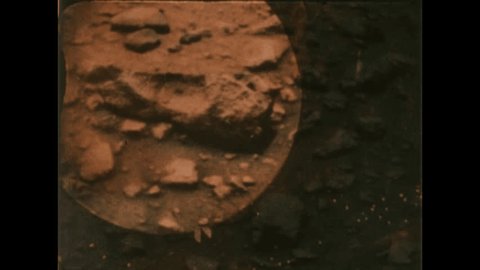 Side-by-side comparison of Jemison, a lush planet with warm sunlight, and a desolate moon, showcasing harsh rock formations, extreme temperature gradients, and sparse vegetation.
Side-by-side comparison of Jemison, a lush planet with warm sunlight, and a desolate moon, showcasing harsh rock formations, extreme temperature gradients, and sparse vegetation.
In stark contrast, a barren and desolate moon orbiting a gas giant presents a much harsher environment. Jagged rock formations, extreme temperature gradients, and sparse vegetation struggling to survive under a harsh, blue-tinged sky create a sense of desolation and danger. The moon's resource-rich deposits attract miners and scavengers, leading to conflicts and hidden secrets. However, here the procedural generation becomes more apparent as environmental variation is minimized due to biome restrictions.
While Starfield attempts to provide unique environmental storytelling opportunities through procedural generation, the repetition of assets and biomes can undermine the sense of discovery and immersion. However, the use of atmospheric effects and post-processing generally enhances the visual fidelity of the environments, creating stunning vistas and immersive experiences.
PC Performance: CPU Bottlenecking & 1% Lows – Frame Time Fallout
Starfield can be a demanding game on PC, particularly when it comes to CPU performance. CPU bottlenecking is a common issue, especially in densely populated cities like New Atlantis or during large-scale space battles, resulting in significant drops in 1% low framerates.
Testing the game on a system equipped with an NVIDIA GeForce RTX 4080, paired with an Intel i5-12600K (a solid mid-range option) and an AMD Ryzen 7 5800X (a higher-end offering known for its multi-core performance), revealed a clear performance disparity. The i5-12600K struggled to maintain consistent framerates in CPU-intensive scenarios, resulting in noticeable stutters, hitches, and significant dips in framerate that negatively impacted the player experience. In contrast, the Ryzen 7 5800X provided a much smoother and more consistent experience, particularly in New Atlantis.
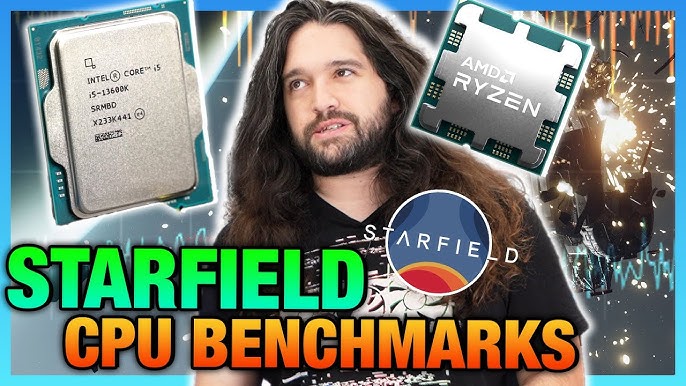 A frame time graph comparing the performance of an Intel i5-12600K versus an AMD Ryzen 7 5800X on 1% low framerates in Starfield, highlighting stutters and frame time variations during a New Atlantis combat scenario.
A frame time graph comparing the performance of an Intel i5-12600K versus an AMD Ryzen 7 5800X on 1% low framerates in Starfield, highlighting stutters and frame time variations during a New Atlantis combat scenario.
Quantifying the performance difference, the Ryzen 7 5800X consistently delivered 10-15% higher 1% low framerates compared to the i5-12600K in CPU-bound areas. This demonstrates that upgrading the CPU can provide a tangible benefit in Starfield, particularly for players aiming for a smooth and consistent gaming experience. Optimizing graphic settings will also help.
Overall Experience: Modding Potential & Community Impact – Skyrim's Echoes
Starfield's long-term potential hinges heavily on its modding support and the transformative impact of the modding community. Given Bethesda's track record with games like Skyrim and Fallout 4, the potential for modding is immense.
Skyrim's extensive library of graphical overhauls, quest expansions, and gameplay tweaks demonstrates the power of modding. Similarly, Fallout 4's settlement building mods and custom weapon additions have significantly extended the game's lifespan. Starfield has the potential to surpass both, thanks to its expansive universe and intricate gameplay systems.
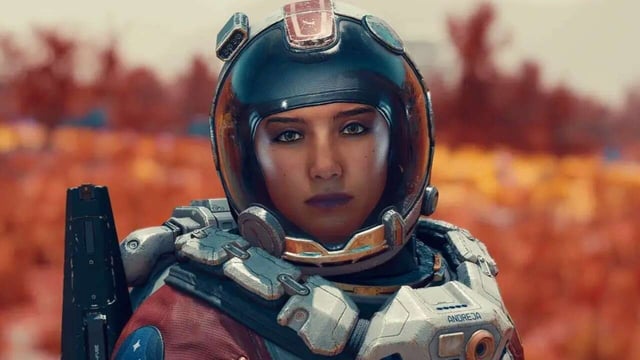 Screenshot showing a developer console with modding commands, suggesting a potential for extensive modifications and community-driven enhancements.
Screenshot showing a developer console with modding commands, suggesting a potential for extensive modifications and community-driven enhancements.
We can anticipate the emergence of mods that enhance textures, add new storylines, expand character customization options, and tweak gameplay mechanics. The potential exists to significantly elevate or fundamentally alter the base game's mechanics, scope, and replayability through community-driven modifications.
It remains to be seen whether Bethesda will allow modifications to the Creation Engine for Starfield. Furthermore, there's a high likelihood that significant bugs will be addressed by the modding community instead of the development team, as has been the case with previous Bethesda titles.
Conclusion: A Promising Start with Room to Grow
Starfield is a complex and ambitious game with both strengths and weaknesses. The ship customization offers impressive depth and significantly impacts gameplay, while the narrative choices provide meaningful agency and moral ambiguity. Graphically, the game delivers stunning vistas, but the procedural generation can lead to repetitive environments. PC performance can be demanding, particularly on the CPU, but the modding potential offers hope for long-term improvement.
Overall, Starfield is a promising start with significant room to grow. It's a game that will likely evolve and improve over time, thanks to the dedication of the modding community. For PC gaming aficionados, Starfield is worth exploring, but be prepared for a few bumps along the way.